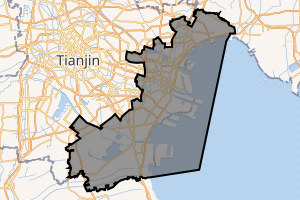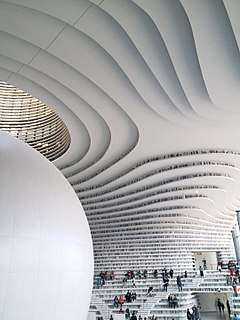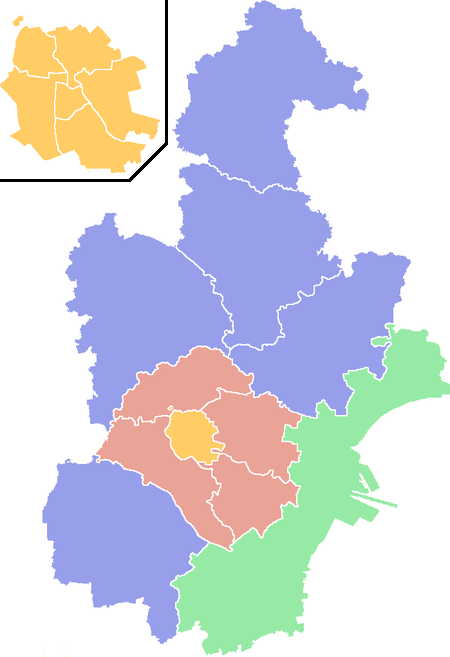Binhai
Binhai, officially known as Binhai New Area (simplified Chinese: 滨海新区; traditional Chinese: 濱海新區; pinyin: Bīnhǎi Xīn Qū), is a sub-provincial district and state-level new area within the jurisdiction of Tianjin Municipality in the People's Republic of China.
Binhai 滨海新区 | ||||||||||||||||||||||||||||||||||||||||||||||||
|---|---|---|---|---|---|---|---|---|---|---|---|---|---|---|---|---|---|---|---|---|---|---|---|---|---|---|---|---|---|---|---|---|---|---|---|---|---|---|---|---|---|---|---|---|---|---|---|---|
| Binhai New Area | ||||||||||||||||||||||||||||||||||||||||||||||||
 TEDA within Binhai | ||||||||||||||||||||||||||||||||||||||||||||||||

| ||||||||||||||||||||||||||||||||||||||||||||||||
| Country | People's Republic of China | |||||||||||||||||||||||||||||||||||||||||||||||
| Municipality | Tianjin | |||||||||||||||||||||||||||||||||||||||||||||||
| Township-level divisions | 19 subdistricts 7 towns | |||||||||||||||||||||||||||||||||||||||||||||||
| District established | 2009 | |||||||||||||||||||||||||||||||||||||||||||||||
| Government | ||||||||||||||||||||||||||||||||||||||||||||||||
| • CPC Secretary | Zhang Yuzhuo | |||||||||||||||||||||||||||||||||||||||||||||||
| • District Governor | Yang Maorong | |||||||||||||||||||||||||||||||||||||||||||||||
| Area | ||||||||||||||||||||||||||||||||||||||||||||||||
| • Total | 2,270 km2 (880 sq mi) | |||||||||||||||||||||||||||||||||||||||||||||||
| Population (2008) | ||||||||||||||||||||||||||||||||||||||||||||||||
| • Total | 1,000,000 | |||||||||||||||||||||||||||||||||||||||||||||||
| • Density | 440/km2 (1,100/sq mi) | |||||||||||||||||||||||||||||||||||||||||||||||
| Time zone | UTC+8 (China Standard) | |||||||||||||||||||||||||||||||||||||||||||||||
| Tianjin district map |
| |||||||||||||||||||||||||||||||||||||||||||||||
| Postal Code | 300000-301900 | |||||||||||||||||||||||||||||||||||||||||||||||
| Website | BH.gov.cn | |||||||||||||||||||||||||||||||||||||||||||||||
| Binhai | |||||||
|---|---|---|---|---|---|---|---|
 | |||||||
| Traditional Chinese | 濱海新區 | ||||||
| Simplified Chinese | 滨海新区 | ||||||
| |||||||
Binhai is intended to replicate development seen in Shenzhen and Pudong in Shanghai.[1]
Geography
Binhai is located on the west coast of the Bohai Sea and east of Tianjin's main urban area. It is a part of the Bohai Economic Rim. It has an area of 3,000 km2 (1,200 sq mi), a coastline of 153 km (95 mi), and contains 700 km2 (270 sq mi) of water and wetlands.[2]
Natural resources
Binhai New Area has 700 square kilometers (270 sq mi) of water and wetlands and a further 1,200 km2 (460 sq mi) of wasteland that is being re-developed into saline land. It has proven oil resources totalling more than 100 million tons, and 193.7 billion cubic meters (6.84 trillion cubic feet) of natural gas.[3]
Administrative divisions
There are 19 subdistricts and 7 towns in the district:[4]
| Name | Chinese (S) | Hanyu Pinyin | Population (2010)[5] | Area (km2) |
|---|---|---|---|---|
| Tanggu Subdistrict | 塘沽街道 | Tánggū Tiēdào | not established | |
| Hangzhou Street Subdistrict | 杭州道街道 | Hángzhōudào Jiēdào | 112,173 | 5.412 |
| Xinhe Subdistrict | 新河街道 | Xīnhé Jiēdào | 73,160 | |
| Dagu Subdistrict (Taku) | 大沽街道 | Dàgū Jiēdào | 43,425 | 138.24 |
| Xinbei Subdistrict | 新北街道 | Xīnběi Jiēdào | 80,702 | |
| Beitang Subdistrict | 北塘街道 | Běitáng Jiēdào | 16,406 | 117 |
| Hujiayuan Subdistrict | 胡家园街道 | Hújiāyuán Jiēdào | 117,235 | 75.2 |
| Hangu Subdistrict | 汉沽街道 | Hàngū Jiēdào | 50,685 | 4.6 |
| Zhaishang Subdistrict | 寨上街道 | Zhàishàng Jiēdào | 66,510 | 4.8 |
| Chadian Subdistrict | 茶淀街道 | Chádiàn Jiēdào | 28,050 | 17.3 |
| Dagang Subdistrict | 大港街道 | Dàgǎng Jiēdào | 91,776 | 4.9 |
| Gulin Subdistrict | 古林街道 | Gǔlín Jiēdào | 47050 | 209 |
| Haibin Subdistrict | 海滨街道 | Hǎibīn Jiēdào | 146,009 | 118 |
| Xincheng town | 新城镇 | Xīnchéng Zhèn | 43,128 | 31 |
| Yangjiabo town | 杨家泊镇 | Yángjiāpō Zhèn | 21,559 | 60.7 |
| Taiping town | 太平镇 | Tàipíng Zhèn | 37,074 | 174.7 |
| Xiaowangzhuang town | 小王庄镇 | Xiǎowángzhuāng Zhèn | 23,084 | 27.8 |
| Zhongtang town | 中塘镇 | Zhōngtáng Zhèn | 55,586 | 30.2 |
| developmental, industrial, & harbor zones | 开发区/类似乡级单位 | Kāifā Qū/Lèisì Xiāng Jí Dānwèi | 831,979 |
- Defunct
- Now part of Tanggu: Yujiapu Subdistrict, Xingang Subdistrict, Xincun Subdistrict north
- Now part of Hangzhou Street: Xiangyang Subdistrict
- Now part of Dagu: Bohaishiyou Subdistrict, Xincun Subdistrict south
- Now part of Hangu: Datian town
- Now part of Chadian: Hexi Subdistrict
- Now part of Dagang: Yingbin Subdistrict, Shengli Subdistrict
- Now part of Haibin: Gangxi Subdistrict
History
The Binhai district was created by the government of China in the 1990s. In 1996 Soviet aircraft carrier Kiev was sold to Binhai Aircraft Park, a theme park in Binhai. The concept was developed by world tourism and attraction consultant Leisure Quest International.[6]
In August 2011, the ex-Kiev was developed into a luxury hotel after renovations costing £9.6 million.[7]
Starting from November 2009, Binhai New Area was consolidated into a district, and the former subordinate districts of Tanggu, Hangu and Dagang were abolished.[8] Binhai New Area consists of nine functional zones: Advanced Manufacturing Zone, Airport-based Industrial Zone, Binhai High-tech Industrial Development Zone, Seaport-based Industrial Zone, Nangang Industrial Zone, Seaport Logistics Zone, Coastal Leisure & Tourism Zone, Sino-Singapore Tianjin Eco-City and the Yujiapu Financial District. In addition, Tianjin Port whose throughput ranks 5th in the world is also located here.
The Binhai district was greatly affected by a large industrial-scale accident in August 2015. On August 12, a series of explosions took place at a port chemical storage facility in Binhai, causing 173 deaths and 797 injuries. The blast had the equivalent of 21 metric tons of TNT or a magnitude-2.9 earthquake, according to the China Earthquake Networks Center. Eight other people remain missing.[9][10]
Economy
Yujiapu Financial District located in Binhai is an under construction financial district with a glitzy skyline envisioned to be a center of world trade and finance.[11] Other parts of Binhai have also been intended to be a base for China's advanced industrial and financial reform and innovation. The Tianjin Economic-Technological Development Area (TEDA) is an early free trade zone.
Tianjin Emissions Exchange organized China's first sulfur dioxide, carbon neutral, contract energy management and energy efficiency product transactions, and established China's first voluntary emission reduction public inquiry system.
A number of major international companies including Rockefeller, Tishman Speyer, Motorola and Airbus have built branches here. For instance, EADS Airbus has already opened an assembly plant for its A320 series airliners, operational since 2009. Domestic companies headquartered in Binhai include noodlemaker Tingyi.[12]
Culture

A large culture complex, Binhai Cultural Center, with five central attractions planned.[13] The centerpiece of the complex is the library that opened in November 2017. The library is nicknamed 'The Eye' because the sphere, which appears like an iris, can be seen from the park outside through an eye-shaped opening.[14]
The remnant of Taku Forts in the form of a gun platform overlooks the Hai River (Peiho River) in Binhai.[15]
Education
Many colleges and universities in Tianjin have branch campuses in Binhai New Area. In 2003, Nankai University established the TEDA Campus in the Tianjin Economic and Technological Development Zone, which is dedicated to research on genomes, functional genomics, biochips, and molecular virology. Tianjin University of Science and Technology will move into Binhai New Area as a whole. The Juilliard College of New York and the Tianjin Conservatory of Music cooperated with the Juilliard Research Institute of the Tianjin Conservatory of Music in the Yujiapu Financial District to provide pre-university and postgraduate education. At the same time, Tianjin Maritime Vocational College, Tianjin Development Zone Vocational and Technical College, Tianjin Binhai Vocational College are located in Binhai New Area.
Transportation
Rail
High speed rail stops in Binhai with Binhai railway station and Tanggu railway station on the Beijing-Tianjin Intercity Railway. Binhai West railway station and Binhai North railway station are stops along the Tianjin–Qinhuangdao High-Speed Railway. Tanggu railway station is also a station on the conventional speed Tianjin–Shanhaiguan Railway.
Metro
Binhai is currently served by one metro line and one tram line operated by Tianjin Metro:


References
- "Archived copy". Archived from the original on 2008-10-11. Retrieved 2008-11-11.CS1 maint: archived copy as title (link)
- 天津市地形地貌. Archived from the original on December 22, 2010. Retrieved 2010-09-22.
- 滨海新区网:地理位置 Archived May 15, 2010, at the Wayback Machine,滨海新区政府网,2010年9月22日查阅
- 2011年统计用区划代码和城乡划分代码:滨海新区 (in Chinese). National Bureau of Statistics of the People's Republic of China. Archived from the original on 2012-10-01. Retrieved 2013-08-08.
- Census Office of the State Council of the People's Republic of China; Population and Employment Statistics Division of the National Bureau of Statistics of the People's Republic of China (2012). 中国2010人口普查分乡、镇、街道资料 (1 ed.). Beijing: China Statistics Print. ISBN 978-7-5037-6660-2.
- "Leisure Quest International - About". Archived from the original on 2014-09-03. Retrieved 2017-04-15.
- Branigan, Tania (10 August 2011). "China launches second aircraft carrier – as luxury hotel". The Guardian. Retrieved 6 December 2013.
- http://news.sohu.com/20091110/n268086616.shtml
- "Tianjin explosion: China sets final death toll at 173, ending search for survivors". the Guardian. Associated Press. Retrieved 14 September 2015.
- 155位"8–12"事故遇难者身份公开 (in Chinese). Sohu. 2 September 2015. Archived from the original on 4 September 2015. Retrieved 2 September 2015.
- Henry Sanderson, Michael Forsythe China's Superbank: Debt, Oil and Influence 2012 -- Page 24
- "联系我们." Master Kong. Retrieved on April 11, 2014. "总部地址:中国天津经济技术开发区第三大街15号"
- "Tianjin's new library looks out of this world". CNN Travel. 22 November 2017.
- Becky Davis (16 November 2017). "China's futuristic library: More fiction than books". France24. AFP.
- Edward Jewitt Wheeler; Isaac Kaufman Funk; William Seaver Woods (1900). The Literary Digest. pp. 68–69.

